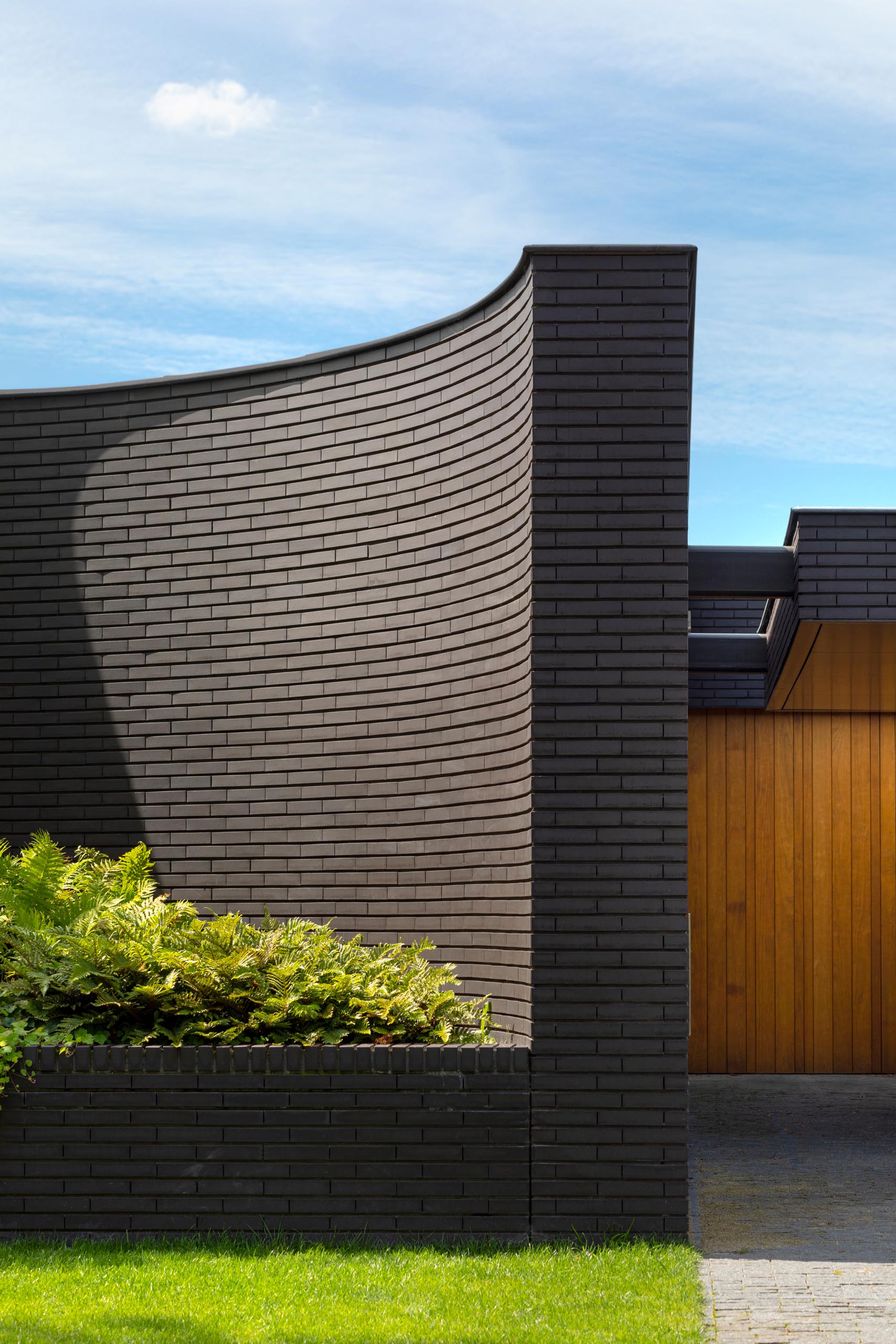Dreaming of a home that blends classic brick appeal with modern design? This article explores the exciting resurgence of brick in contemporary architecture, showcasing how this timeless material is being reimagined for today’s homes.
Rethinking Brick: A Modern Renaissance
Brick, a material steeped in history, is experiencing a revival in modern architecture. Its versatility allows for a spectrum of designs, from sleek, minimalist facades to warm, rustic exteriors. This isn’t your grandmother’s brick house—unless she had a keen eye for contemporary design! Modern brick homes are showcasing the material’s surprising adaptability. For other home design ideas, check out modern barn houses.
One key factor driving brick’s comeback is its remarkable flexibility. Available in a vast array of colors and textures—from classic red to cool grays, stark whites, and even painted finishes—brick empowers architects and designers to create truly distinctive homes.
Elevating Brick: Key Design Elements
- Innovative Bricklaying: Bricklaying is evolving into an art form. Different bond patterns create visual intrigue, while techniques like perforated brick screens, curved walls, and textured surfaces transform ordinary walls into architectural statements.
- The Power of Color: Beyond the traditional red, today’s brick comes in a diverse palette of colors, from earthy browns and warm yellows to sophisticated grays and bold blacks. Color selection can dramatically influence a home’s character, establishing anything from striking contrasts to serene harmony.
- Material Fusion: Modern brick houses often integrate other materials, such as expansive glass windows for natural light, sleek metal accents for an industrial touch, and minimalist landscaping to complement clean lines. The focus on indoor-outdoor living seamlessly connects the home with nature.
Building with Brick: Practical Considerations
- Regulations First: Before embarking on your brick house journey, research local building codes and regulations. These rules can impact design choices and working with experienced professionals ensures compliance.
- Sustainability Matters: Brick boasts impressive eco-friendly credentials. Highly durable and recyclable, it can last for generations. Its excellent thermal mass properties contribute to indoor temperature regulation and potential energy savings.
The Future of Brick: Innovation and Evolution
- The Brick Revival: Brick’s resurgence isn’t solely aesthetic. Its cost-effectiveness due to durability and low maintenance makes it a practical choice. Ongoing research suggests that advancements in production methods may yield even more sustainable brick options.
- Regional Influences: Modern brick house designs vary regionally. Climate plays a crucial role; hotter climates often prioritize shade and ventilation, while colder regions focus on insulation and energy efficiency. Cultural traditions further contribute to unique regional styles.
- What Lies Ahead?: The future of brick is ripe with possibilities. Experts believe innovations like self-heating bricks or those capable of generating solar power could revolutionize how we build and live.
Key Points:
- Modern brick houses offer versatility and adaptability.
- Design Elements:
- Creative bricklaying techniques enhance facades.
- Diverse color options allow for varied aesthetics.
- Mixing brick with other materials creates a striking look.
- Practical Considerations:
- Adhere to local building codes and regulations.
- Brick’s durability and recyclability make it sustainable.
- Future of Brick:
- Advanced production methods promise greater sustainability.
- Regional influences shape unique design styles.
- Technological advancements may lead to innovative functionalities.
Comparison of Traditional vs. Modern Brick Houses:
| Feature | Traditional Brick House | Modern Brick House |
|---|---|---|
| Color | Primarily Red | Wide Range of Colors |
| Bricklaying | Standard Bond Patterns | Creative Patterns and Textures |
| Architectural Style | Classic, Often Ornate | Minimalist, Contemporary, or Blend of Styles |
| Sustainability | Durable, but Production Can Be Less Eco-friendly | Focus on Eco-friendly Production and Use |
| Other Materials | Limited Use | Often Combined with Glass, Metal, and Wood |
Modern brick homes demonstrate that tradition and innovation can coexist beautifully. They offer a unique blend of timeless appeal and contemporary design, making them an attractive option for those seeking both beauty and practicality.
The Enduring Appeal (and Evolving Reality) of Brick Houses in Modern Construction
Brick houses: a symbol of strength and timeless appeal. But do they still build them? Absolutely. While construction methods have evolved, the allure of a brick home remains strong. Let’s explore the current state of brick house construction.
Brick homes are still built, but the solid brick construction of the past has largely given way to brick veneer in modern American homes. Instead of multiple layers of brick, a single layer is applied over wood framing, providing the classic brick aesthetic at a lower cost.
Why Aren’t All Houses Brick Anymore?
The shift from solid brick to veneer stems from several factors. Cost, labor intensity, and evolving building codes have contributed to the decline of solid brick construction, making alternative materials more attractive to builders. Brick, while durable, can be expensive, and skilled bricklaying adds to the cost. Building codes often require additional reinforcement for solid brick walls, further increasing expenses. This has led to the rise of alternative materials like wood, concrete, and steel, which offer faster and often cheaper construction options.
Despite this shift, brick retains its appeal for durability, aesthetics, and perceived value, making it a popular choice for veneer and accent features. Modern brick homes leverage design innovations and thin brick options to achieve the classic brick look while mitigating some of the traditional cost and labor challenges.
| Feature | Solid Brick Construction | Brick Veneer Construction |
|---|---|---|
| Structure | Multiple layers of brick form structural walls | Single layer of brick over wood or other frame |
| Cost | Higher | Lower |
| Construction Time | Longer | Faster |
| Durability | High | High (due to the brick exterior) |
Our understanding of building materials is constantly evolving. While brick veneer is currently dominant, future innovations may reshape brick construction.
The Hidden Costs of Brick Houses: Unveiling the Disadvantages
Brick houses exude charm and durability. However, it’s crucial to consider potential downsides before committing to this classic material. While aesthetically pleasing and durable, brick houses come with a hefty price tag, both initially and for potential repairs, often exceeding other building materials.
Beyond the Charm: Practical Considerations and Disadvantages of Brick Houses
Cost Considerations:
One major drawback is cost. Bricks are typically more expensive than other materials, and specialized labor adds to the expense. Repairs, while less frequent, can also be costly due to the need for skilled masons.
Moisture Challenges:
The porous nature of brick, though contributing to its eco-friendliness, makes it susceptible to moisture damage, mold, and efflorescence, requiring specialized maintenance. Water absorption can lead to mold, efflorescence, and even structural damage if not properly addressed.
Renovation Hurdles:
Modifying a brick house, such as painting or expanding, presents significant challenges and expenses compared to homes built with other materials. Renovations can be complex and expensive due to the material’s rigidity.
Aesthetic Limitations:
Despite their classic appeal, brick homes offer limited color choices and can be difficult to personalize, potentially impacting resale value in certain markets. While various brick types exist, design flexibility is less than with other materials.
Ongoing research into building materials may mitigate some of these disadvantages in the future.
The True Cost of a Brick House: 2024 Building Guide & Price Breakdown
Considering a brick house? Let’s discuss the crucial factor: cost. Brick houses cost 6-7% more than vinyl siding and average $200,000-$400,000 to build, demanding skilled labor and longer construction timelines. While brick offers longevity, low maintenance, and energy efficiency, the higher upfront cost requires careful budget consideration.
It’s important to differentiate between building a new brick house and adding a brick veneer to an existing one. The cost to brick an existing house (veneer) is significantly less ($16,000-$34,000 for 2,000 sq ft) than building a full brick structure.
Is a Brick House Worth the Investment? Weighing the Costs and Benefits
Building a new brick house typically ranges from $200,000 to $400,000, with an average of $302,000. Factors like size, style, and location influence the final price. Adding a brick veneer is a more affordable option, costing between $16,000 and $34,000 for a 2,000 sq ft house.
Construction Considerations: Brick construction takes longer and requires skilled labor, impacting both timelines and budgets.
Pros and Cons of Brick Homes:
| Pros | Cons |
|---|---|
| Longevity | Higher upfront cost |
| Low maintenance | Longer construction time |
| Energy efficiency | Specialized labor required |
| Durability | |
| Pest and weather resistance |
Brick’s durability and desirability contribute to higher resale value, potentially offsetting the initial investment over time. However, it’s essential to conduct thorough research on current market prices in your area. While national averages provide a starting point, regional variations can significantly impact costs.
Are you interested in learning more about the newest trends in modern home design? Explore modern brick homes to get inspired by its unique designs and architectural styles. Check out modern barn houses for more home design ideas.
- Does Ammonia Kill Mold? The Truth About Using It for Removal - April 15, 2025
- Does Bleach Kill Spiders? Effectiveness, Safety, and Better Alternatives - April 15, 2025
- Does Soap Expire? How to Tell if Your Soap Has Gone Bad - April 15, 2025










